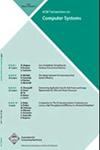大规模分布式系统的高带宽数据传播
IF 1.8
4区 计算机科学
Q2 COMPUTER SCIENCE, THEORY & METHODS
引用次数: 27
摘要
本文主要研究多接收机数据分发问题。最初,IP多播形成了有效支持这种分发的基础。最近出现了支持点对多点通信的覆盖网络。这两种技术都侧重于构建根植于源的树,以便在所有感兴趣的接收者之间分发内容。然而,我们认为树在数据传播方面有两个基本限制。首先,由于所有数据都来自单一父节点,因此参与者必须经常不断地搜索具有可接受带宽水平的父节点。其次,由于数据包丢失和故障,可用带宽沿树单调递减。为了解决这些限制,我们提出了Bullet,这是一种数据传播网格,它利用终端主机的计算和存储能力来创建一个分布结构,其中节点从多个对等点并行接收数据。为了使网格提供更好的带宽和可靠性,我们需要解决几个关键问题:(i)在网格上传播不相交的数据,(ii)定位丢失的内容,(iii)找到与谁对等(对等策略),(iv)从所有对等点以正确的速率检索数据(流量控制),以及(v)从故障中恢复并适应动态变化的网络条件。此外,系统应该是自我调节的,应该有很少的用户可调参数设置。我们描述了在Internet上可工作的部署系统中解决所有这些问题的方法。Bullet的性能比最先进的系统(包括BitTorrent)高出25-70%,并且在一系列部署设置中表现出强大的性能和可靠性。此外,我们发现,相对于基于树的解决方案,Bullet减少了执行昂贵的带宽探测的需要。本文章由计算机程序翻译,如有差异,请以英文原文为准。
High-bandwidth data dissemination for large-scale distributed systems
This article focuses on the multireceiver data dissemination problem. Initially, IP multicast formed the basis for efficiently supporting such distribution. More recently, overlay networks have emerged to support point-to-multipoint communication. Both techniques focus on constructing trees rooted at the source to distribute content among all interested receivers. We argue, however, that trees have two fundamental limitations for data dissemination. First, since all data comes from a single parent, participants must often continuously probe in search of a parent with an acceptable level of bandwidth. Second, due to packet losses and failures, available bandwidth is monotonically decreasing down the tree.
To address these limitations, we present Bullet, a data dissemination mesh that takes advantage of the computational and storage capabilities of end hosts to create a distribution structure where a node receives data in parallel from multiple peers. For the mesh to deliver improved bandwidth and reliability, we need to solve several key problems: (i) disseminating disjoint data over the mesh, (ii) locating missing content, (iii) finding who to peer with (peering strategy), (iv) retrieving data at the right rate from all peers (flow control), and (v) recovering from failures and adapting to dynamically changing network conditions. Additionally, the system should be self-adjusting and should have few user-adjustable parameter settings. We describe our approach to addressing all of these problems in a working, deployed system across the Internet. Bullet outperforms state-of-the-art systems, including BitTorrent, by 25-70% and exhibits strong performance and reliability in a range of deployment settings. In addition, we find that, relative to tree-based solutions, Bullet reduces the need to perform expensive bandwidth probing.
求助全文
通过发布文献求助,成功后即可免费获取论文全文。
去求助
来源期刊

ACM Transactions on Computer Systems
工程技术-计算机:理论方法
CiteScore
4.00
自引率
0.00%
发文量
7
审稿时长
1 months
期刊介绍:
ACM Transactions on Computer Systems (TOCS) presents research and development results on the design, implementation, analysis, evaluation, and use of computer systems and systems software. The term "computer systems" is interpreted broadly and includes operating systems, systems architecture and hardware, distributed systems, optimizing compilers, and the interaction between systems and computer networks. Articles appearing in TOCS will tend either to present new techniques and concepts, or to report on experiences and experiments with actual systems. Insights useful to system designers, builders, and users will be emphasized.
TOCS publishes research and technical papers, both short and long. It includes technical correspondence to permit commentary on technical topics and on previously published papers.
 求助内容:
求助内容: 应助结果提醒方式:
应助结果提醒方式:


